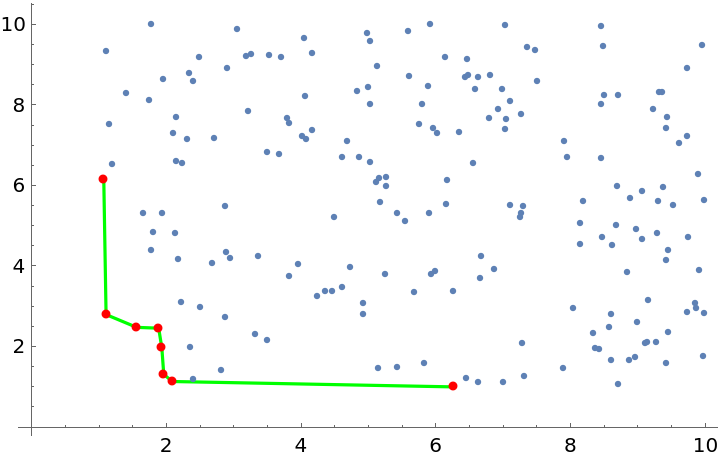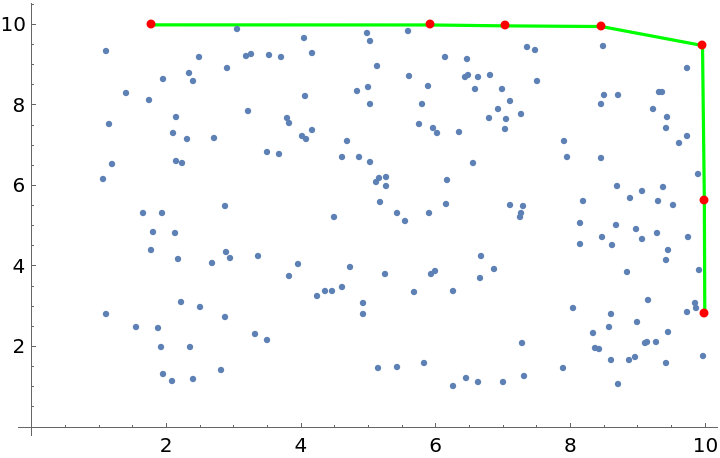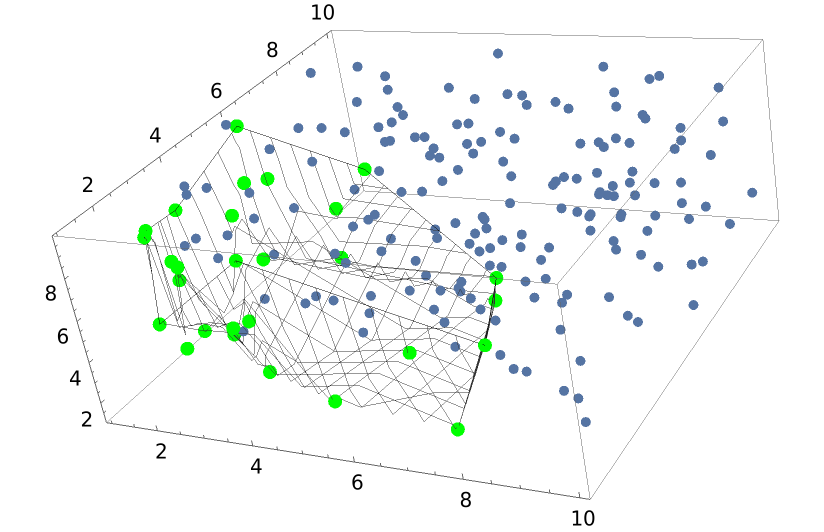Wolfram Function Repository
Instant-use add-on functions for the Wolfram Language
Function Repository Resource:
Find the Pareto-minimal points in a set of numeric vectors
ResourceFunction["ParetoListMinima"][points] gives the subset of points that are Pareto-minimal. |
Find the Pareto minima of five points in 3D:
| In[1]:= |
| Out[1]= |
Create a list of 20 random integer vectors in 3D:
| In[2]:= |
| Out[3]= |
Compute the Pareto minima for this set:
| In[4]:= |
| Out[4]= |
Compute the Pareto minima for a set of 200 points in 2D:
| In[5]:= | ![SeedRandom[1234];
pts = RandomReal[{1, 10}, {200, 2}];
mins = ResourceFunction["ParetoListMinima"][pts];
nonmins = DeleteCases[pts, Alternatives @@ mins];
{Length[mins], Length[nonmins]}](https://www.wolframcloud.com/obj/resourcesystem/images/2ce/2ce60e14-fdca-41ac-bc36-7736da51350b/5387763c5a6c4595.png) |
| Out[9]= |
Show the Pareto minima connected by segments, along with the other points:
| In[10]:= | ![Show[{ListPlot[Style[SortBy[mins, First], Green], Joined -> True], ListPlot[Style[SortBy[mins, First], Red]], ListPlot[nonmins]}, PlotRange -> All, AxesOrigin -> 0]](https://www.wolframcloud.com/obj/resourcesystem/images/2ce/2ce60e14-fdca-41ac-bc36-7736da51350b/5b3380817a3a19fd.png) |
| Out[10]= |  |
Pareto-maximal points are defined in the same way as minimal points, except using GreaterEqual as the component-wise inequality. One can use ParetoListMinima in a simple way to compute the Pareto-maximal points:
| In[11]:= | ![ParetoListMaxima[list_] := -ResourceFunction["ParetoListMinima"][-list]
SeedRandom[1234];
pts = RandomReal[{1, 10}, {200, 2}];
maxes = ParetoListMaxima[pts];
nonmaxes = DeleteCases[pts, Alternatives @@ maxes];
{Length[maxes], Length[nonmaxes]}](https://www.wolframcloud.com/obj/resourcesystem/images/2ce/2ce60e14-fdca-41ac-bc36-7736da51350b/25805b67a3435565.png) |
| Out[12]= |
Show the Pareto maxima connected by segments, along with the other points:
| In[13]:= | ![Show[{ListPlot[Style[SortBy[maxes, First], Green], Joined -> True], ListPlot[Style[SortBy[maxes, First], Red]], ListPlot[nonmaxes]}, PlotRange -> All, AxesOrigin -> 0]](https://www.wolframcloud.com/obj/resourcesystem/images/2ce/2ce60e14-fdca-41ac-bc36-7736da51350b/6cb9a1d0d2d78bca.png) |
| Out[13]= |  |
Compute Pareto minima for 200 points in 3D:
| In[14]:= | ![SeedRandom[1234];
pts = RandomReal[{1, 10}, {200, 3}];
mins = ResourceFunction["ParetoListMinima"][pts];
nonmins = DeleteCases[pts, Alternatives @@ mins];
{Length[mins], Length[nonmins]}](https://www.wolframcloud.com/obj/resourcesystem/images/2ce/2ce60e14-fdca-41ac-bc36-7736da51350b/64efc102adc93fb5.png) |
| Out[18]= |
Show the Pareto maxima, the planar mesh they define, and the non-minima above them:
| In[19]:= |
| Out[19]= |  |
This work is licensed under a Creative Commons Attribution 4.0 International License